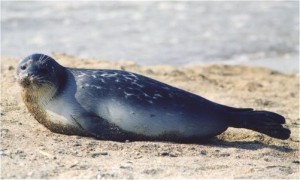
Caspian seal
For whatever reason, the editors of the Encyclopedia of Marine Mammals decided to cover Caspian and Baikal seals together in one article. What do they have in common besides both being seals you ask? Well, it turns out that Caspian and Baikal seals both ended up living along land locked bodies of water. A very unusual characteristic for seals.
Baikal seals live in and along the shores of Lake Baikal in Siberia giving them the second distinction of being the only pinniped to inhabit freshwater. Caspian seals live along the Caspian Sea (contains salt water, but only a third the salinity of ocean water), which is bordered by five countries including Iran and Russia. The Caspian sea and Baikal Lake have the distinction of the being the first and second largest lakes in the world. And somehow the Caspian and Baikal seals found their way to these inland shores.
The coolest thing about Baikal seals is that they have enlarged eyes to help them find fish in Lake Baikal’s deep clear waters. This reminds me of Little Red Riding Hood talking to the wolf, “My what big eyes you have!” Baikal seals do have crazy large eyes based on the photo in the encyclopedia, but unfortunately the only photo I could find online without copyright issues has a Baikal seal with its eyes closed. Annoying!
Caspian seals also have awesome large eyes, but the seal in the photo is squinting so it’s hard to tell. These big eyes are also used to find fish and crustaceans for dinner. The encyclopedia article actually lists seven species of fish by their scientific names, like I have all the scientific names of fish in the world memorized. So Caspian seals eat a bunch of different fish, that’s the bottom-line.

Photo credit: Uryah
Unfortunately, the other thing Caspian and Baikal seals share in common is mass die offs. In 1987-1988, thousands of Baikal seals died of canine distemper virus and a similar virus killed thousands of Caspian seals in 1997. Bummer for the seals indeed. Of course, hunting has also taken a toll on seal populations. “According to Khuraskin and Pochtoyeva, 115,000-174,000 Caspian seals have been hunted annually since the early nineteenth century.” After reading the full article in the encyclopedia full of grim sickness and hunting statistics, it’s a wonder that there are any Baikal and Caspian seals left at all.
Those poor seals! Very interessting article!